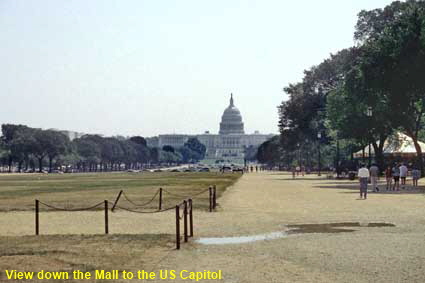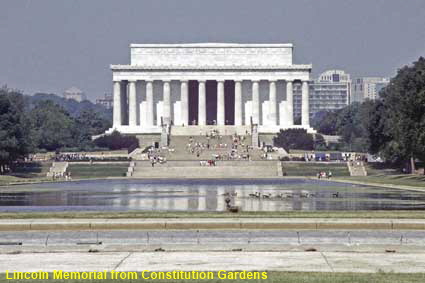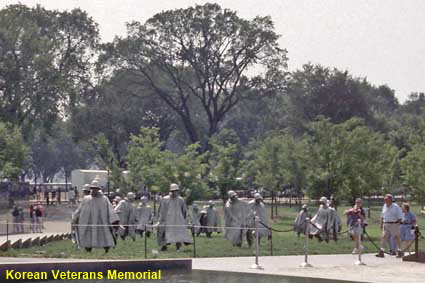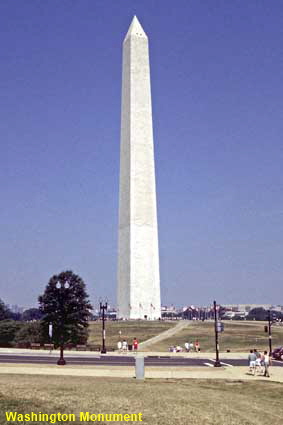Pierre Charles L'Enfant included the National Mall in his plans, running from the US Capitol to the site of the Washington Monument. Combined with the gardens and park at the western end the overall open space now extends from the US Capitol to the banks of the Potomac River. The distance from the Capitol to the Lincoln Memorial close to the bank of the river is 3.5 kilometres (2.1 miles). The Mall shows the benefits of building Washington DC on a green field site. To build a mall on this scale in a European capital would require wholesale destruction of much of their history. Mussolini’s attempt in Rome at this type of grandeur, the Via dei Fori Imperiali, is only half the length and much, much narrower.
View down the National Mall to the US Capitol
While the National Mall is technically the area from the Washington Monument to the US Capitol, most people now regard Constitution Gardens and West Potomac Park at the western end as part of The Mall. This picture looks east along the original National Mall to the US Capitol. Although hidden by the trees, the sides of the National Mall are lined with Museums covering History, Natural History, Art, Air & Space.
The Mall


Click on Minimap to navigate
Home > US States > Midatlantic USA > Washington DC >
Vietnam Veterans Memorial
Vietnam was the longest war in US history and the most controversial certainly until history has had time to judge the recent US activities in Iraq. The design by Yale architecture student Maya Ying Lin was chosen from over 1400 submitted in a public competition. The memorial comprises two polished black granite walls set in a V shape. Inscribed on the wall in chronological order are the names of more than 58,000 dead or missing from the 1956 to 1975 War. The Vietnam Veterans Memorial was dedicated on November 13, 1982. For some people Maya Ying Lin's memorial was too modern and incompatible with the nearby grand monuments, so in 1984 a flagpole and statue of three Vietnam servicemen sculpted by Frederick Hart was added at one entrance. Click Tab 2 to see the statue.

DLU100607
Jefferson Memorial from the Mall
Technically we are now straying away from The Mall as the Jefferson Memorial is situated to the south of it, directly opposite the White House on the other side of a basin off the Potomac River, which is hidden in this picture. President Franklin Roosevelt felt that a monument to Jefferson should join those of Washington and Lincoln. Architect John Russell Pope based the circular domed design on the Pantheon in Rome. The design was chosen in 1936. The death of Pope in 1937 resulted in changes to the design and delayed the start of construction to 1939. It was completed in 1943.
Washington Monument
Pierre Charles L'Enfant’s plans included a statue of George Washington on horseback at the point where the axis of the National Mall lined up with the White House, but this was not implemented. After Washington’s death in 1799 the question of a Monument to the first President was raised once again. Plans for a federally funded mausoleum were put forward then abandoned. Instead it was decided to build a memorial by public subscription. An Egyptian style obelisk was part of the original plans for a “National Pantheon” drawn up in 1836 by Robert Mills. By 1848 enough money had been raised to begin construction, but not quite in the place proposed by L'Enfant. The original site proved too to be too marshy, so the Monument was built off centre to the White House. Limited funds slowed construction and forced the plans to be scaled back. The injection of Federal funds in 1876 speeded up construction and the Washington Monument was finally completed in 1884. Standing 168 metres (550 feet) high it is the largest masonry structure in the world.
Korean Veterans Memorial
The ghostly figures in the middle of this picture are not tourists, they are statues of 19 US soldiers fighting in Korea. In 1950 the communist government of North Korea launched an attack on South Korea. The US fought under the UN flag to repel the invasion with the loss of over 54,000 lives. Designed architectural firm of Cooper - Lechy, the statues and reflecting pool of the Korean Veterans Memorial were dedicated in 1995.

Lincoln Memorial from Constitution Gardens
Abraham Lincoln holds a special place in American history. It was considered fitting that the man who won the Civil War and saved the Union should have a substantial memorial in the capital of the USA. The location chosen on newly reclaimed parkland by the Potomac River had the effect of extending the Mall right down to the river. Designed by Henry Bacon, construction of the Lincoln Memorial began in 1914 and it took 8 years to complete. Inside the Memorial a huge statue of a seated Abraham Lincoln stares out along the Mall towards the Washington Monument and the US Capitol. Daniel Chester French was chosen as sculptor only after work on the Memorial had commenced. The interior of the Memorial is inscribed with many of Lincoln’s famous speeches. Click Tab 2 to see the statue.


To move forwards or backwards through the Washington DC trail click the arrows above, or select your next destination on the Minimap.


© Mike Elsden 1981 - 2025
The contents of this page may not be reproduced in full or in part without permission

